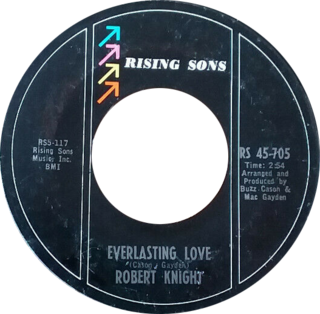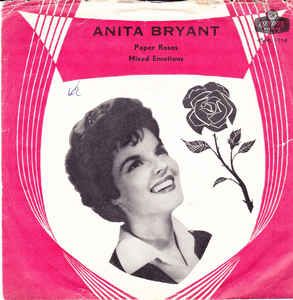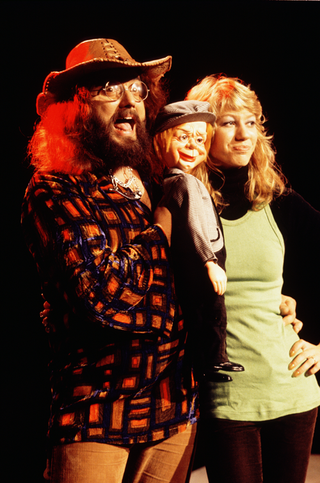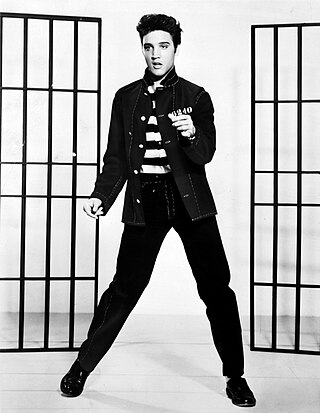Christie are an English soft rock band that formed at the end of the 1960s. They are best remembered for their UK chart-topping hit single "Yellow River", released in 1970, which hit number one in 26 countries that year.

The Sweet are a British glam rock band who rose to prominence in the 1970s. Their best-known line-up consisted of lead vocalist Brian Connolly, bass-player Steve Priest, guitarist Andy Scott and drummer Mick Tucker. The group were originally called The Sweetshop.

Edison Lighthouse are an English pop band, formed in London in 1969. The band was best known for their 1970 hit single "Love Grows " recorded in late 1969.

"Everlasting Love" is a song written by Buzz Cason and Mac Gayden, originally a 1967 hit for Robert Knight and since remade numerous times, most successfully by Love Affair, as well as Town Criers, Carl Carlton, Sandra Cretu, and Gloria Estefan. The original version of "Everlasting Love" was recorded by Knight in Nashville, with Cason and Gayden aiming to produce it in a Motown style reminiscent of the Four Tops and the Temptations. When released as a single, the song reached No. 13 on the US chart in 1967. Subsequently, the song has reached the US top 40 three times, most successfully as performed by Carl Carlton, peaking at No. 6 in 1974, with more moderate success by the duo Rex Smith and Rachel Sweet and Gloria Estefan.

"The Ballroom Blitz" is a song by British glam rock band The Sweet, written by Nicky Chinn and Mike Chapman. The song reached number one in Canada, number two in the UK Singles Chart and the Australian Chart, and number five on the US Billboard Hot 100. It remains an enduring favourite, with more than 144 million streams on Spotify alone by the end of 2022.
John William Bristol was an American musician, most famous as a songwriter and record producer for the Motown label in the late 1960s and early 1970s. He was a native of Morganton, North Carolina, about which he wrote an eponymous song. His composition "Love Me for a Reason" saw global success when covered by The Osmonds including a number 1 in the UK charts in 1974. His most famous solo recording was "Hang On in There Baby" recorded in 1974, which reached the Top Ten in the United States and number 3 in the United Kingdom. Both singles were in the UK top 5 simultaneously.

"The Joker" is a song by the Steve Miller Band from their 1973 album The Joker. Released as a single in October 1973, the song topped the US Billboard Hot 100 in early 1974 and reached the top 20 in Australia, Canada, and the Netherlands. More than 16 years later, in September 1990, "The Joker" reached number one on the UK Singles Chart for two weeks after being used in "Great Deal", a Hugh Johnson-directed television advertisement for Levi's, thus holding the record for the longest gap between transatlantic chart-toppers. This reissue of "The Joker" also topped the Irish Singles Chart, the New Zealand Singles Chart, the Dutch Nationale Top 100, and the Dutch Top 40.
"Young Love" is a popular song, written by Ric Cartey and Carole Joyner, and published in 1956. The original version was recorded by Ric Cartey with the Jiva-Tones on November 24, 1956. It was released in 1956 by Stars Records as catalog number 539 and one month later by RCA Records as catalog number 47-6751. Cartey's version never charted.

"The Twelfth of Never" is a popular song written in 1956 and first recorded by Johnny Mathis the following year. The title is a popular expression, which is used as the date of a future occurrence that will never come to pass. In the case of the song, "the 12th of Never" is given as the date on which the singer will stop loving his beloved, thus indicating that he will always love her.
Kevin Stephen Johnson is an Australian singer-songwriter. Popular in the 1970s, his biggest hit is "Rock and Roll ", which peaked at No. 4 on the Australian Kent Music Report Singles Chart in 1973. He also had a top 20 hit with "Bonnie Please Don't Go" in 1971. "Rock and Roll" is one of the most covered songs written by an Australian with 27 different artists recording the song in 1975 alone. Covers of "Rock and Roll " came from fellow Australians, Col Joye and Dig Richards, and from international artists, Mac Davis, Terry Jacks, Gary Glitter, Joe Dassin, The Cats and Tom Jones. Davis' rendition became the highest charting version on the Billboard Hot 100, reaching No. 15 in 1975.

"Sugar Baby Love", recorded in autumn 1973 and released in January 1974, is a bubblegum pop song, and the debut single of The Rubettes. Written by Wayne Bickerton and Tony Waddington and produced by Bickerton, engineered by John Mackswith at Lansdowne Recording Studios, and with lead vocals by Paul Da Vinci, "Sugar Baby Love" was the band's one and only number one single in the UK Singles Chart, spending four weeks at the top of the chart in May 1974.

"Love Will Keep Us Together" is a song written by Neil Sedaka and Howard Greenfield. It was first recorded by Sedaka in 1973. The brother-sister duo Mac and Katie Kissoon recorded their version of the song in 1973. American pop duo Captain & Tennille covered the song in 1975, with instrumental backing almost entirely by “Captain” Daryl Dragon, with the exception of drums played by Hal Blaine; their version became a worldwide hit.

"Paper Roses" is a popular song written and composed by Fred Spielman and Janice Torre. It first was a top five hit in 1960 for Anita Bryant. Marie Osmond recorded it in 1973 and took her version to number one on the US country chart.

"Rock the Boat" is a song by American trio The Hues Corporation, written by Wally Holmes. "Rock the Boat" was first featured on their 1973 debut studio album Freedom for the Stallion. It was released as the third single from the album in early 1974, to follow up Stallion's title song, which had peaked at number sixty-three on the Hot 100, and "Miracle Maker " which did not chart.

"My Coo Ca Choo" is the first successful release for Alvin Stardust, reaching number two in the UK Singles Chart in December 1973. The glam rock single fared even better in Australia, where it spent seven weeks at the top and was the best charting single in the country in 1974.

Mouth and MacNeal was a Dutch pop duo that enjoyed commercial success in the 1970s. They are best known for their million selling recording of "How Do You Do" in 1972, which topped the Dutch chart and became a US top ten hit, also reaching number 2 in Canada, and for representing the Netherlands at the 1974 Eurovision Song Contest, finishing third with the song "I See a Star", which went on to become a UK top ten hit.

The discography of the American pop group the Carpenters consists of 14 studio albums, two Christmas albums, two live albums, 49 singles, and numerous compilation albums. The duo was made up of siblings Karen and Richard Carpenter.

"I'm Gonna Love You Just a Little More Baby" is a song written, produced and recorded by Barry White.
The following is a comprehensive discography of British rock band the Sweet.

The singles discography of Elvis Presley began in 1954 with the release of his first commercial single, "That's All Right". Following his regional success with Sun Records, Presley was signed to RCA Victor on November 20, 1955. Presley's first single with RCA, "Heartbreak Hotel", was a worldwide hit, reaching the No. 1 position in four countries and the top 10 in many other countries. Other hit singles from the 1950s include "Hound Dog", "Don't Be Cruel", "Love Me Tender", Too Much", "All Shook Up", "(Let Me Be Your) Teddy Bear", "Jailhouse Rock", "Don't", "Hard Headed Woman" and "A Big Hunk o' Love". On March 24, 1958, Presley entered the United States Army at Memphis, Tennessee, and was stationed in Germany. He left active duty on March 5, 1960.














